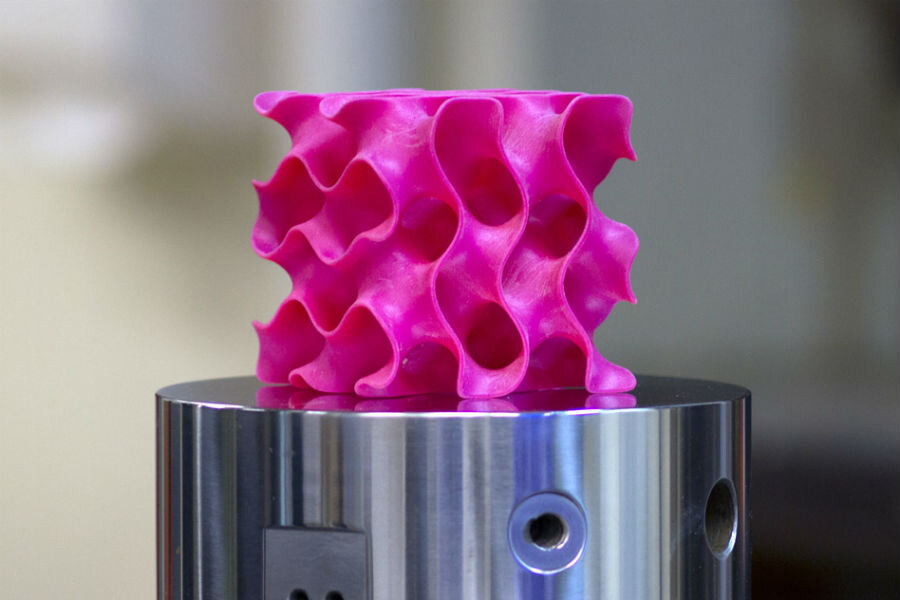3D graphene: MIT scientists develop super-light, super-strong structure
Loading...
Many scientists consider graphene to be one of the most potentially useful materials ever created. The atom-thick chain of carbon atoms are strong, light, and promise many applications, from energy storage to pollution removal to waterproof coating.
While graphene has been studied since the 1940s, scientists have had considerable trouble constructing it into a structurally useful form on a three-dimensional level. But now, scientists at MIT have figured out how to build up graphene into useful, 3-D shapes with the potential to be lighter and stronger than steel.
The new research marks an important step forward for the material. The hexagonal structure is essentially an "unrolled" carbon nanotube only an atom thick, usually only functional on a two-dimensional level. Despite this limitation, graphene is more than 100 times stronger than steel, and converting that two-dimensional strength into a structure usable for three-dimensional building materials has for years been something of a holy grail for graphene researchers. And now, scientists may be one step closer to that conversion.
The journal Science Advances published the results of the MIT study, describing how the researchers created a porous, three-dimensional graphene material. During the synthesis of the graphene, the team added heat and pressure in order to compress small flakes of graphene together, creating complex spongelike structures similar to corals and diatoms, a kind of unicellular algae. These structures, while not very dense, have a large surface area and are extremely strong; one graphene sample had only 5 percent of the density of steel, but was 10 times stronger.
The researchers had hoped that they might be able to create useful graphene structures that would actually be lighter than air, but computer modeling at an atomic level found that such structures would be crushed by outside air pressure. But the scientists did create scaled-up 3D-printed models of complex geometric structures called gyroids that could theoretically form the basis of a new class of super-strong and lightweight materials that would not even be necessarily limited to graphene.
"You can replace the material itself with anything," Markus Buehler, lead author of the study, said in a statement from MIT. "The geometry is the dominant factor. It's something that has the potential to transfer to many things."
Theoretically, a graphene designed with these gyroid shapes on a microscopic level could be even stronger than the strongest porous graphene material the team was able to create.
"Once we created these 3-D structures, we wanted to see what's the limit — what's the strongest possible material we can produce," Zhao Qin, study co-author, said in the statement.
The new MIT study builds on work by scientists like Andre Geim and Knostantin Novoselov, who won the 2010 Nobel Prize in Physics for isolating graphene. Once they first isolated the material in 2004, scientists around the world began in earnest to figure out practical uses for the unusual material. As Pete Spotts reported for The Christian Science Monitor in October 2010:
Graphene in essence is a two-dimensional crystal with atoms neatly arranged in a pattern that looks like chicken wire. Once the winners showed how to separate a layer of graphene from a block of graphite, materials scientists quickly set their sights on it.
Subsequent work has demonstrated that the vanishingly thin material is at least 100 times stronger than steel, conducts electricity more efficiently than copper, is highly flexible and the most transparent material known, and is remarkably efficient at conducting heat.
....
Graphene "has all the potential to change your life in the same way that plastics did," Andre Geim told The Associated Press after the Nobel Committee announced that he and colleague Konstantin Novoselov had won the $1.5-million prize. "It is really exciting."
For now, the ability to create ideally-strong gyroids on the scale of atom-thin graphene is likely beyond any current manufacturing methods. But the MIT researchers hope that one day, the geometric knowledge gained from the study can be used to create stronger building materials for anything from personal devices to buildings.
"The combination of computational modeling with 3-D-printing-based experiments used in this paper is a powerful new approach in engineering research," Huajian Gao, a professor of engineering at Brown University who was not involved in the study, said in the statement. "It is impressive to see the scaling laws initially derived from nanoscale simulations resurface in macroscale experiments under the help of 3-D printing."








